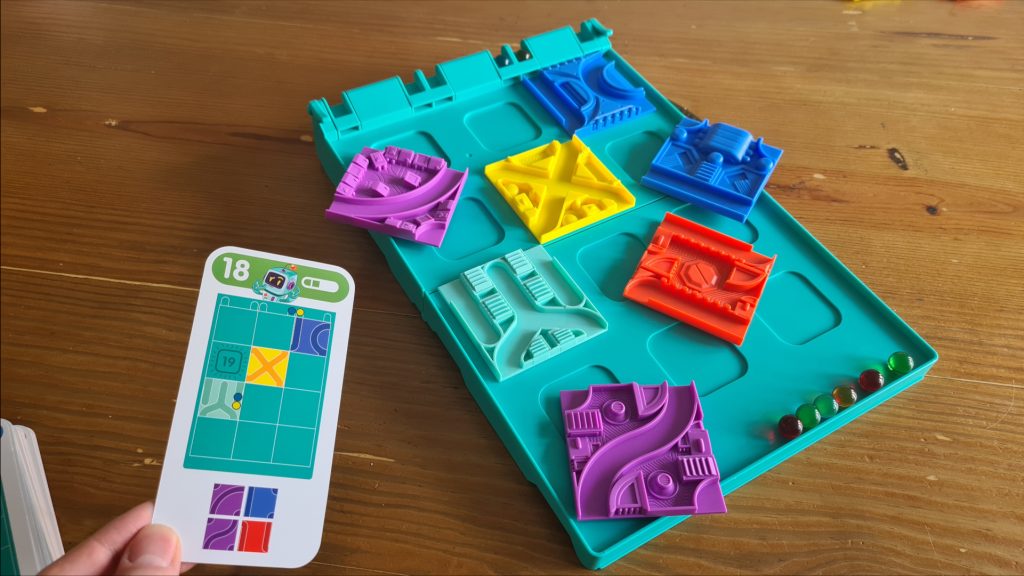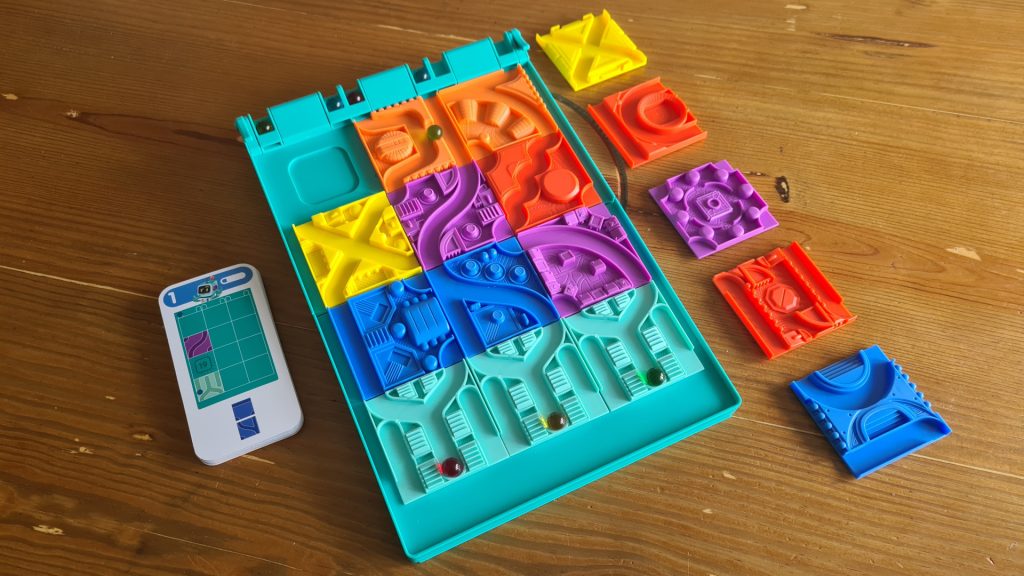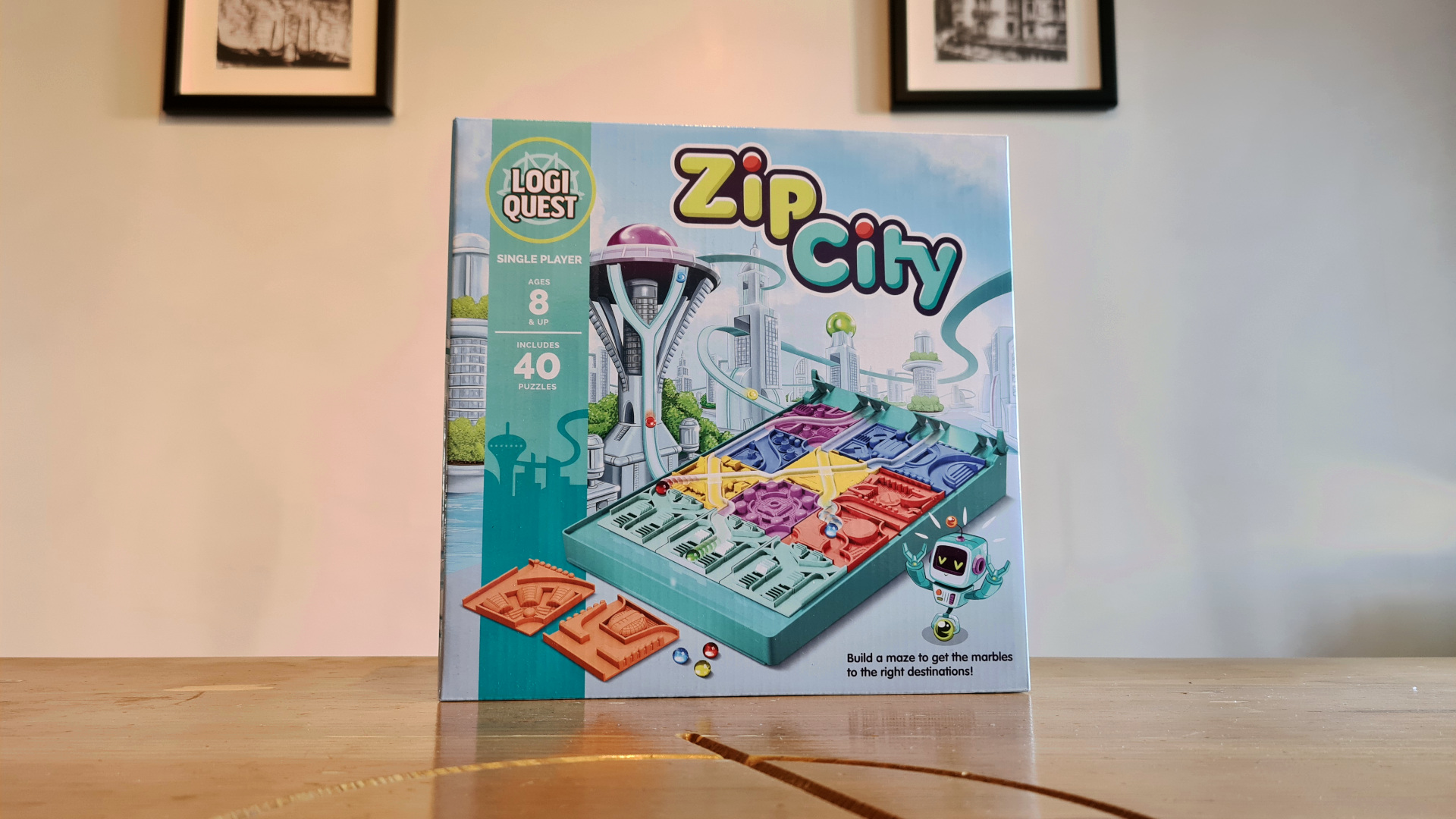Logiquest Zip City is the second of four puzzle style experiences from Mixlore. Following on from Shadow Glyphs, which we reviewed last week, Zip City revolves around marble runs and puzzle pieces, which won’t always take the marbles to where you want them to be! Predominantly sold as a single player experience, Zip City sees the player constructing the unique transport system of the city. However, will you want to… keep on rolling… those marbles? Let’s find out!
Setting up Zip City is as simple as opening the box up and taking out all of the marbles, puzzle cards and track tiles. You start by then selecting a puzzle card, with each depicting a unique puzzle – coming with a number and a difficulty rating from easy to expert. The puzzle card shows the layout of locked in tiles, where the marbles start, where they must finish to complete the puzzle and which other track tiles can be used to complete the puzzle.
With no timer or penalty for trying and testing positioned tiles, players are free to solve the puzzles at their own pace. Using only the indicated tiles, the player must work with those locked in by the puzzle card so that when the marble gate is opened they roll down along the tracks and reach the indicated finish place. Importantly, the marbles must not only end up in the right places they must be in the correct ordering, as shown on the puzzle card.

Whenever the player thinks they have all the tiles in the right place then it is as simple as lifting the starting gate to find out. If they end up in the right end zone and in the right order then the puzzle is complete, else it’s back to the drawing board. Players aren’t completely left to their own devices if stuck. Each puzzle card has at least one hint. These are numbered so that they can be looked up in the rulebook. A brilliant touch is that these hints aren’t sequentially numbered so it’s incredibly hard to spoil future puzzles by spotting the next hint. Each puzzle card also features the exact solution on the reverse, so no peeking ahead of time.
As the rules suggest, sometimes the pieces already placed, the locked track tiles, can be there almost as a distraction. It’s great to see that occasionally one of the remaining tiles was also somewhat of a red herring too. This just keeps players on their feet when working through the puzzles. It was done just enough that it made me double guess, head scratch and get a bit stumped, without fully expecting it to occur every puzzle.
While each card has a solution on the reverse, there are sometimes more than one way to solve the puzzles. As the puzzles get harder, with more pieces this becomes more probable but harder to see. A couple of times when working through the puzzles this happened where two tiles were switched around, often offering similar paths. The rules state that the marbles just need to end in the right place and order so I certainly counted these as a win! Working through the 40 included puzzles took a few hours, across a couple of days. Thankfully, these aren’t necessarily the easiest puzzle solutions to remember so they are somewhat replayable – though an app with “endless” puzzles would have been nice.
Zip City does have to be placed extremely flat, else some of the puzzles won’t complete despite all of the tiles being placed into the right slots, in the right orientations. Even on a flat table though it doesn’t always work perfectly – perhaps just needing a quick reset. This only occurred a few times when playing through the 40 puzzles, when the solution was constructed but the marbles got stuck, or perhaps the special orange piece, where the marble starts on it, didn’t get nudged enough for the marble to drop. It rarely happened thankfully, and each time I simply reset the marbles and released them a second time and it successfully worked.

Thematically there is little there to grab onto. Supposedly Zip City is a futuristic busy city, which uses gravity driven Zip Spheres to transport citizens. At no point during the puzzle solving does this come across, and as a puzzle game experience this is neither surprising or all that problematic. Taking a step back out of the puzzle space though, the tiles all link to this theme, with tiles featuring houses, a factory and even a football ground on one. It’s a shame when playing you don’t really take these details in, focusing only on the routes of the tracks and not the details surrounding them.
Production wise the tiles are of a great size, so it’s not a fiddly game to play. Their bright colours make it easy to tell most apart, though some tiles look rather similar – the two yellow track tiles being the biggest offenders. The ramp where the tiles are placed folds up with all of the components fitting inside. This is a great storage solution, though there is a bit of a tetris like puzzle fitting it all back in. One probably accidentally useful component is the small card in the puzzle deck that is about discovering the Logiquest range. This turned out to be a handy bookmark in the puzzle deck so you can pick up from where you got to at a later date.
There is something extreme satisfying about marble runs and Logiquest Zip City combines this with puzzles harmoniously. While most will blast through the first 10 puzzle cards, being the easy puzzles, the hard and expert challenges take some real thought and thinking to crack. The production is strong, though the details on the track tiles are almost lost when trying to solve the puzzles. With 40 puzzles Zip City it’s not the longest experience to complete, still it is a satisfying one.
(Editor’s Note: Logiquest Zip City was provided to us by Asmodee for the review. The game is currently available from local board game stores! Find your local store here.)

